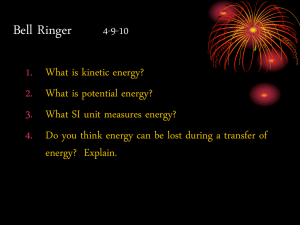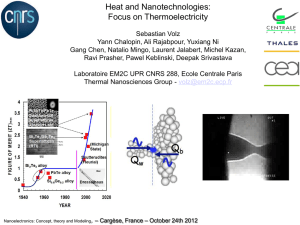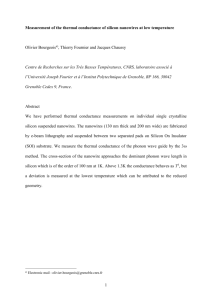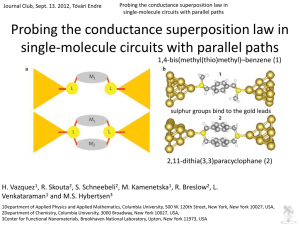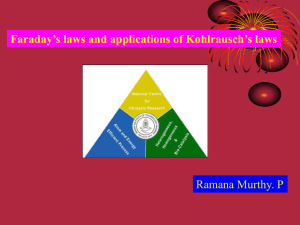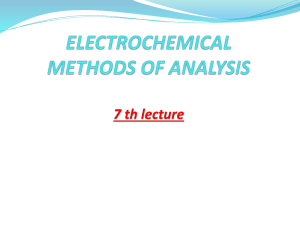L11_Cahill_GuestLecture_2010
advertisement
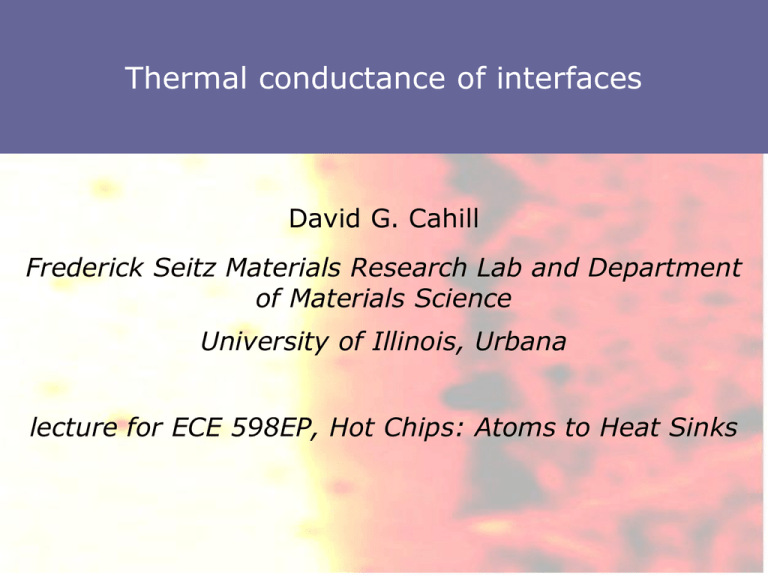
Thermal conductance of interfaces David G. Cahill Frederick Seitz Materials Research Lab and Department of Materials Science University of Illinois, Urbana lecture for ECE 598EP, Hot Chips: Atoms to Heat Sinks Interfaces are critical at the nanoscale • Low thermal conductivity in nanostructured materials – improved thermoelectric energy conversion – improved thermal barriers • High thermal conductivity composites and suspensions 50 nm Interfaces are critical at the nanoscale • High power density devices – solid state lighting – high speed electronics – nanoscale sensors Micrograph of tunneling magnetoresistive sensor for 120 GB drives, M. Kautzky (Seagate) Interface thermal conductance • Thermal conductivity L is a property of the continuum • Thermal conductance (per unit area) G is a property of an interface Interface thermal conductance (2001) • Observations (2001) span a very limited range – Al/sapphire Pb/diamond – no data for hard/soft • lattice dynamics (LD) theory by Stoner and Maris (1993) • Diffuse mismatch (DMM) theory by Swartz and Pohl (1987) Acoustic and diffuse mismatch theory • Acoustic mismatch (AMM) – perfect interface: average transmission coefficient <t> given by differences in acoustic impedance, Z=rv – lattice dynamics (LD) incorporates microscopics • Diffuse mismatch (DMM) – disordered interface: <t> given by differences in densities of vibrational states • Predicted large range of G not observed (2001) • For similar materials, scattering decreases G • For dissimilar materials, scattering increases G 2005: Factor of 60 range at room temperature W/Al2O3 Au/water PMMA/Al2O3 nanotube/alkane Modulated pump-probe apparatus f=10 MHz rf lock-in psec acoustics and time-domain thermoreflectance • Optical constants and reflectivity depend on strain and temperature • Strain echoes give acoustic properties or film thickness • Thermoreflectance gives thermal properties Modulated pump-probe • four times scales: – – – – pulse duration, 0.3 ps pulse spacing, 12.5 ns modulation period, 100 ns time-delay, t t Bonello et al. (1998) Analytical solution to 3D heat flow in an infinite half-space • spherical thermal wave • Hankel transform of surface temperature • Multiply by transform of Gaussian heat source and take inverse transform • Gaussian-weighted surface temperature Two basic types of experiments • thermal conductivity of bulk samples and thermal conductance of interfaces • thermal conductivity of thin films Iterative solution for layered geometries Einstein (1911) • coupled the Einstein oscillators to 26 neighbors • heat transport as a random walk of thermal energy between atoms; time scale of ½ vibrational period • did not realize waves (phonons) are the normal modes of a crystal Works well for homogeneous disordered materials amorphous disordered crystal W/Al2O3 nanolaminates • room temperature data • sputtered in pure Ar • atomic-layer deposition at 177 and 300 °C, S. George (U. Colorado) • G = 220 MW m-2 K-1 50 nm Interfaces between highly dissimilar materials DOS Material A (Pb, Bi) w Material B (diamond, BeO) w • high temperature limit of the radiation limit G k 3 3 b max 2 D v max : vibrational cutoff frequency of material A ( max 1.8 THz for Bi, 2.23 THz for Pb) vD : Debye velocity of material B R. J. Stoner and H. J. Maris, Phys.Rev.B 48, 22, 16373 (1993) Thermoreflectance data for Bi and Pb interfaces 10 -Vin/Vout 5 Bi/H/Si(111) Pb/H/Diamond 2 Bi/H/Diamond 1 0.05 0.1 0.2 0.5 t (ns) 1 2 5 Room temperature thermal conductance • Pb and Bi show similar behavior. Electron phonon coupling is not an important channel. • Weak dependence on Debye velocity of the substrate. • Pb/diamond a factor of two smaller than Stoner and Maris but still far too large for a purely elastic process. Temperature dependence of the conductance • Excess conductance has a linear temperature dependence (not observed by Stoner and Maris). • Suggests inelastic (3phonon?) channel for heat transport TDTR is all optical method: adaptable to “extreme” environments such as high pressure Diamond anvil cell What can pressure dependence tell us about thermal transport at the nanoscale? • “Classical” models (DMM, AMM) for interface thermal conductance do not include physics of the interface itself: phonon transport is only a function of the properties of the two solids. • Elastic constants and phonon spectrum of typical materials do not change much between 0 and 10 GPa. • But interface bonding might be weak and highly anharmonic Clean SiC anvil at high temperatures and deposit Al film in-situ by sputtering At high pressures, “clean” and “dirty” interfaces agree with diffuse-mismatch model • Work in progress. a) Al deposited on native oxide of SiC b) Al deposited in-situ on SiC cleaned in high vacuum at 1000°C Carbon nanotube/alkane interfaces • Experiment: nanotube suspension in surfactant (SDS) micelles in D2O (with M. Strano) • Computation by P. Keblinski: nanotube in octane Transient absorption • Optical absorption depends on temperature of the nanotube • Cooling rate gives interface conductance G = 12 MW m-2 K-1 • MD suggests channel is low frequency squeezing and bending modes strongly coupled to the fluid. Critical aspect ratio for fiber composite • Isotropic fiber composite with high conductivity fibers (and infinite interface conductance) • But this conductivity if obtained only if the aspect ratio of the fiber is high Simulation: constant heat flux • Pour heat into the tube and remove from the octane liquid • G = 25 MW m-2 K-1 -8 Constant heat flux 5x10 W; heat sink from L = 18 to L = 20 Å 600 Nanotube 550 T, K 500 450 Liquid 400 350 300 250 0 2 4 6 8 10 L, Å 12 14 16 18 20 • Mimic the experiment: heat nanotube suddenly and let system equlibrate • Use heat capacity to convert time constant to conductance. In the limit of long tubes: G = 22 MW m-2 K-1 T(tube) - T(liquid) [K] Simulation: relaxation time C K G= A 100 0 10 20 30 40 50 time [ps] 60 70 80 Simulation: Mechanisms for interface heat conduction 0.035 nanot ube temperature 500 450 400 350 30 ps 0.030 liquid t emperature 1/TAU [1/ps] 550 Conductance Mode temperature [K] 600 Lowest frequency bending mode 0.025 0.020 360 280 0.015 240 0.010 200 300 0.005 215 ps 0 3 6 9 12 Mode frequency [tHz] 15 0.000 0.002 0.004 140 0.006 0.008 100 0.010 1/tube length 1/Nnt • Carbon nanotubes have a small number of low frequency modes associated with bending and squeezing. Only these modes can couple strongly with the liquid. Metal-metal conductance: Al/Cu/sapphire samples and thermoreflectance data • Two samples: Cu thicknesses of 218 nm and 1570 nm Al Cu Al2O3 Thermal Conductance of Al-Cu • Metal-metal interface conductance is huge 4 GW/m2-K at 298 K • And increases linearly with temperature Diffuse mismatch model for electrons • Transmission coefficient G for electron of energy E from 12; v(E) is velocity; D(E) is density of states. • Thermal conductance G; N(E,T) is occupation • Simplify, define Z = gvFT Thermal Conductance of Al-Cu • Diffuse mismatch model for electrons using in units of GW/m2-K




